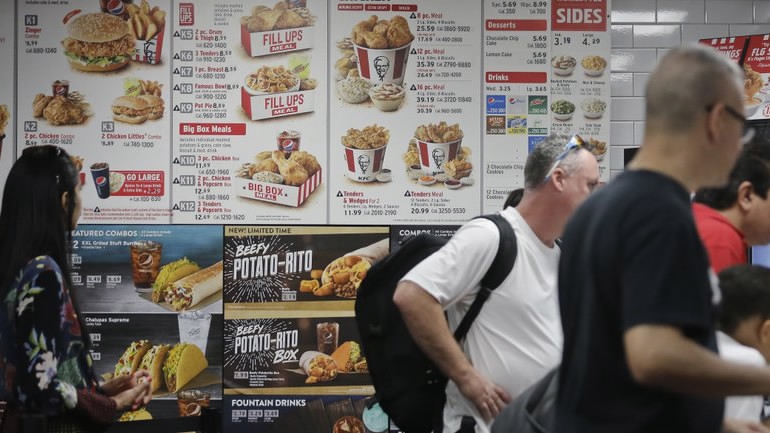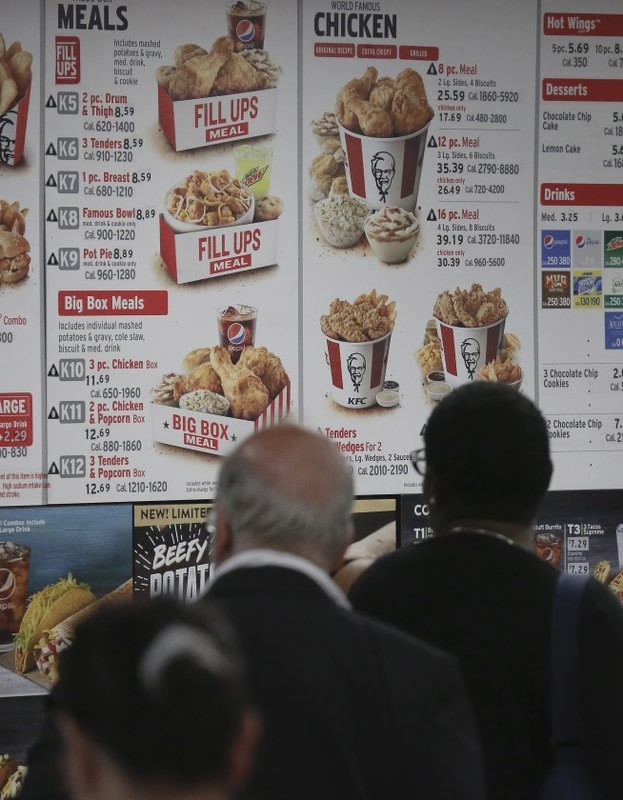
Tech & Sci
10:05, 27-Aug-2017
NYC calorie count rule scrutinized in courts of law, and science

As a court fight simmers over New York City’s pioneering requirement for calorie counts on chain restaurant menus, scientists say the jury’s still out on whether giving people the numbers spurs them to eat healthier.
The city said that by requiring eateries to tell people that their 4 US dollars cheeseburger will also cost them about 540 calories is also helping diners make informed choices in an era of rising obesity.
New York City’s first-in-the-nation rule took full effect in 2008. It was copied by other cities and counties and a half-dozen states and became part of President Barack Obama’s 2010 health care overhaul. The repeatedly delayed federal regulation, which extends to grocery and convenience store chain menus in the city, is now set to take effect next year.

A calories tag is displayed with cooked food at a Whole Foods Market, in New York city, US, August 24, 2017. /AP Photo
A calories tag is displayed with cooked food at a Whole Foods Market, in New York city, US, August 24, 2017. /AP Photo
But plenty of opponents to the idea remain, including some who question its effectiveness.
Studies to date haven’t conclusively shown that restaurant-goers, on the whole, actually order lighter foods when the calorie tally is right there. It appears to influence some people, in some settings, and possibly restaurants’ recipes, researchers say.
“What we haven’t seen so far is any sort of dramatic change in the number of calories purchased at the population level,” says Dr. Brian Elbel, a New York University health policy professor who co-authored a 2014 analysis of 31 studies on the subject, including his own. But “some people are definitely seeing and using this information.”

A KFC menu displays meal selections with the calorie count, in New York city, US, August 24, 2017. /AP Photo
A KFC menu displays meal selections with the calorie count, in New York city, US, August 24, 2017. /AP Photo
The National Association of Convenience Stores cited some of that research when it sued to stop New York City from enforcing a retooled rule expanding the calorie labeling requirements to groceries and other small markets, saying the city was forcing businesses to spend thousands of dollars complying with a local rule when a national one is coming.
On Friday, a Manhattan federal judge approved a deal among lawyers on both sides that ensures the city will not enforce the expansion before May. The agreement also ensures that calorie counts won’t disappear from chains that have posted them for years.
“This addresses the most basic of needs — providing us with nutrition information to make healthful decisions at the time of decision-making,” spokeswoman Stephanie Buhle said this week.

A deli worker helps a customer with a selection of prepared foods at a Whole Foods Market, in New York city, US, August 24, 2017. /AP Photo
A deli worker helps a customer with a selection of prepared foods at a Whole Foods Market, in New York city, US, August 24, 2017. /AP Photo
About 1 million New Yorkers see calorie data every day, according to Health Department research, and a 2011 Quinnipiac University poll found 79 percent of city voters found the information useful.
But if it’s useful, do people use it?
At least three research analysts have said there’s no definitive proof it leads to lower-calorie orders for diners and eateries in general, though researchers involved note that they may not have captured small effects.
Some scientists feel the research shows the policy falls short. Menu labeling “might not be the proper prescription,” Indiana University medical professor Dr. Aaron Campbell wrote in The New York Times in 2015.

Customers look over a KFC menu labeled with calorie counts, in New York city, US, August 24, 2017. /AP Photo
Customers look over a KFC menu labeled with calorie counts, in New York city, US, August 24, 2017. /AP Photo
But some individual studies have found effects. Some Stanford University business professors’ 2010 examination of over 100 million Starbucks purchases found that menu postings trimmed the calories in customers’ orders by an average of 6 percent, from 247 to 232.
In another example, a 2013 study in Seattle and surrounding King County found some calorie-cutting, though particularly by women and customers who said they took menu postings into account when ordering.
While the overall evidence is mixed, “I think it’s still reasonable to say that among those who see and use the information, it is helpful to them — and why wouldn’t you want to give consumers information?” says University of Washington medical professor Jim Krieger, a co-author of the King County study. He also runs Healthy Food America, a food policy advocacy group.

File: Information cards provide calorie count and price for food items on display at a Whole Foods store, in New York city, US, May 3, 2017. /AP Photo
File: Information cards provide calorie count and price for food items on display at a Whole Foods store, in New York city, US, May 3, 2017. /AP Photo
Krieger and others have also done research that suggests some restaurants offer lower-calorie dishes after labeling requirements. And researchers note that calorie counts could have hard-to-measure effects, such as helping gradually shift eating norms and expectations.
“It’s unreasonable to say, ‘If this one policy doesn’t reduce obesity, it’s a failure,’ because the chances any one policy will do that are incredibly small,” says Dr. Christina Roberto, a University of Pennsylvania health policy professor who’s worked on several studies on menu calorie counts.
“We don’t even have the best data yet. And I think there are a lot of common-sense reasons to do it,” she says.
11001km
Source(s): AP

SITEMAP
Copyright © 2018 CGTN. Beijing ICP prepared NO.16065310-3
Copyright © 2018 CGTN. Beijing ICP prepared NO.16065310-3